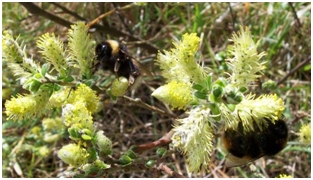Spring foraging resources and the behaviour of pollinating insects in fixed dune ecosystems
DOI:
https://doi.org/10.26786/1920-7603(2014)14Abstract
In temperate climates, foraging resources for pollinating insects are especially important in early spring when animals emerge from hibernation and initiate annual life cycles. One habitat, protected under EU law, which provides resources for a range of pollinating insects, but has received little research attention, is fixed (grey) dunes. Fixed dunes often contain creeping willow (Salix repens, Salicaceae), which may be an important early season resource for obligate flower visitors. We examined the springtime activity of flower visitors in fixed dune ecosystems in relation to sugar concentration and composition in nectar, composition of essential amino acids in pollen, and floral abundance. We also investigated whether the presence or absence of S. repens influenced the abundance and species richness of three obligate flower visiting guilds (solitary bees, bumblebees and hoverflies) in eight sites along the eastern and southern coasts of Ireland.
Higher insect visitation rates were observed to species whose nectar contained greater concentrations of glucose and fructose. Solitary bee visitation rates were related to % Essential Amino Acid (EAA) in pollen and floral species richness. Ulex europeaus, and S. repens were the most abundant flowering species, but visitation rates were not related to floral abundance. Higher abundances of bumblebees and hoverflies were discovered at sites where S. repens was present. This study raises further questions about the nutritional requirements and preferences of obligate flower visitors in fixed dune ecosystems in spring time.

Downloads
Published
How to Cite
Issue
Section
License
Copyright (c) 2014 Aoife T. O'Rourke, Una Fitzpatrick, Jane C. Stout

This work is licensed under a Creative Commons Attribution 4.0 International License.











